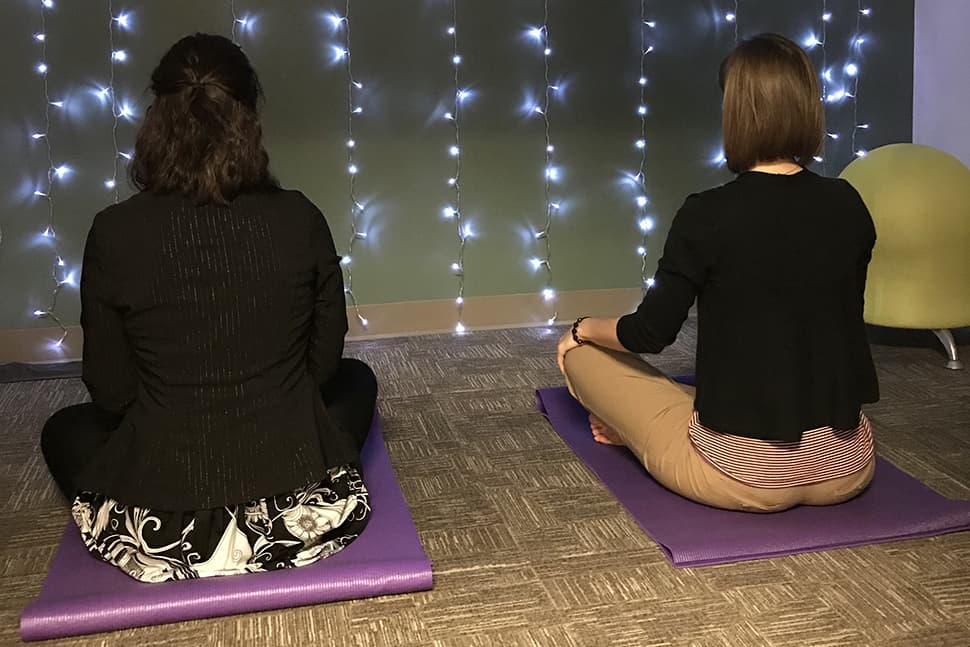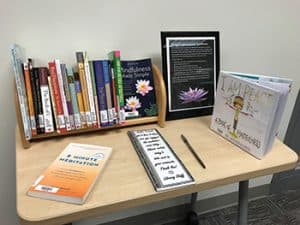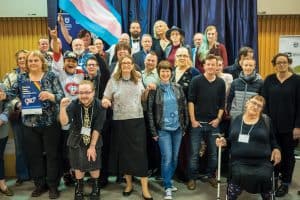
Maybe the greatest thing about Humboldt State University’s (HSU) new, meant-to-be-shared meditation room is that everyone who uses it seems to be getting along. “I’m actually surprised,” says Cyril Oberlander, who directs the HSU library in Arcata, California. “No reported conflicts of use at all. Let’s keep that going.” He adds that the room’s success lies in its accommodating a wide variety of thoughtful practices.
Oberlander is one of an increasing number of academic library directors who oversees what are variously called “reflection rooms” or “meditation rooms.” Around the US, students are using these spaces for prayer, yoga, scripture study, or simply for an escape between tough classes.
It is a recent and growing trend for colleges, where a rising number of Muslim students have been searching for places to pray. The University of Kansas (KU) Libraries in Lawrence opened their third reflection room in August at the request of the Muslim Student Association.
“We had students who were at the end of rows in the stacks, seeking privacy for their prayers,” says Kevin Smith, dean of libraries at KU. “We’re trying to meet the student need, and this is what they tell us they need.”
Smith started noticing Muslim students praying in public yet secluded areas, then began receiving requests from their student organizations for a convenient location to practice their faith. Most branches of Islam require worshipers to stop what they are doing and pray at set points throughout the day; having a close-by spot to do so prevents young Muslims from having to run back to their dorm rooms or duck into the hinterlands of the stacks.
Providing for this interest was simple: In both cases, the deans found little-used offices and retrofit them with some soft new furniture and calming paint colors. Decorations are minimal, with no religious symbols, since the room is open to all faiths. Oberlander and Smith both say it took little staff time and a zero or minimal budget to revitalize unused space.
The rooms need to be quiet—no group study, no group singing. Electronic devices are discouraged, because that would probably defeat the purpose. “A lot of people want to get away from the distractions,” Oberlander says, “and that’s hard to do in the age of the smartphone.”
At HSU, the rooms have locked doors and students check the keys out daily, although the library has also opened a Meditation Corner in an informal, experiential space called the Brain Booth, which has no doors and is designed to introduce students to scientific research on the effects of mindfulness, attention, and contemplation. At KU, the rooms have screens instead of doors, because Smith worried that having to check out a key would discourage use.

The West Campus library at Tulsa (Okla.) Community College (TCC) now has a meditation room featuring strings of blue lights covering an otherwise dark blue, minimally decorated wall. The soft lights encourage a peaceful mood that is conducive to reflection. TCC Reference and Instruction Librarian Megan Donald and the library staff came up with the idea and presented it to college leadership for approval.
West Campus Library Director Emily Tichenor says that TCC has a “diverse student body that includes many first-time and first-generation college students for whom meditation and mindfulness practices can help reduce stress and anxiety.” Inside the room—a repurposed storage closet in a far corner of the library—is a small table filled with books on meditation, yoga mats, and several Zenergy ball chairs. Student newspaper editor Dylan Axsom profiled the room in an August 2017 story for The TCC Connection.
Smith, Oberlander, and Tichenor have had no noise complaints, no “I was here first” disputes, no “I can’t practice my religion in a room where you practice yours” declarations.
Of course, as with any emerging trend, resistance is bound to occur. In early February 2017 at the University of Michigan in Ann Arbor, someone urinated on a prayer rug in a reflection room in the basement of Shapiro Undergraduate Library. In a press release, school officials said it was “disappointing and upsetting,” and that campus police were investigating the damage as a “bias-motivated crime.”
At the public libraries in Los Angeles, Seattle, and Washington, D.C., officials say they have not heard of meditation rooms outside of college campuses. At D.C. Public Library, Media Relations Manager George Williams says they recently finished a capital improvement project at several branches that created study rooms for groups of two to four. The mini-conference rooms have glass walls, and patrons can use them as they please, but none are intended specifically for individual, drop-in mind-easing.
“We can see what’s happening inside them, but we don’t know, in a meaningful way, that we can say ‘Yes, these rooms are being used for that purpose,’” Williams says. “The library does not keep track of how patrons use the study rooms.”
In talking about reflection or meditation rooms, Smith cited the ancient Greek proverb that the key to learning is to “know thyself.” Oberlander doubts that any HSU students see the rooms as inherently sacred; rather, they probably view them as multipurpose facilities.
“In the library, we work so hard on shared spaces,” he says. “If higher education is going to be sustainable, it has to be about shared spaces and shared experiences.”



And I thought it wasn’t possible for university students to be any more coddled and cossetted.
When I was a child and got in trouble, I was often made to stand or sit in the corner for 10, maybe 15 minutes, in complete silence and alone, as a penalty. How is it coddling someone to give them a space to sit alone, in complete quiet, and think? I know this is a real problem in our current society, but you can’t just use that term haphazardly without being thoughtful about its actual meaning beforehand.